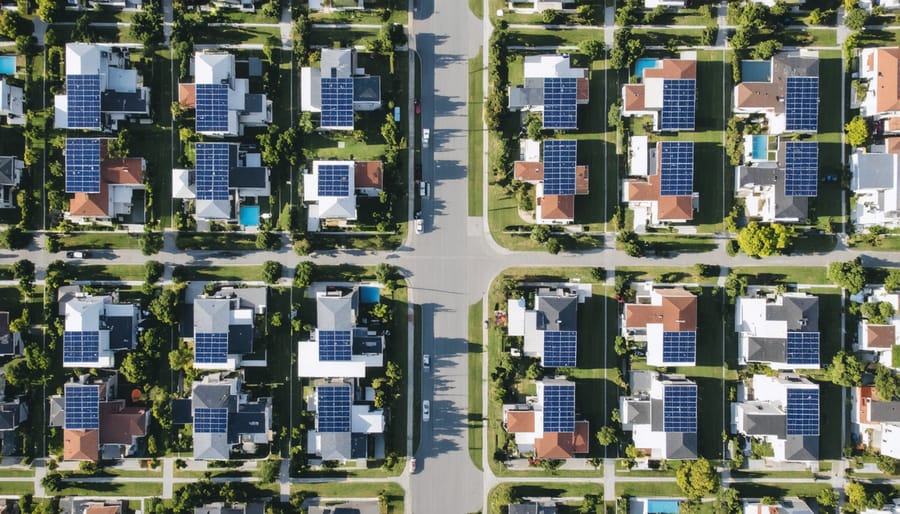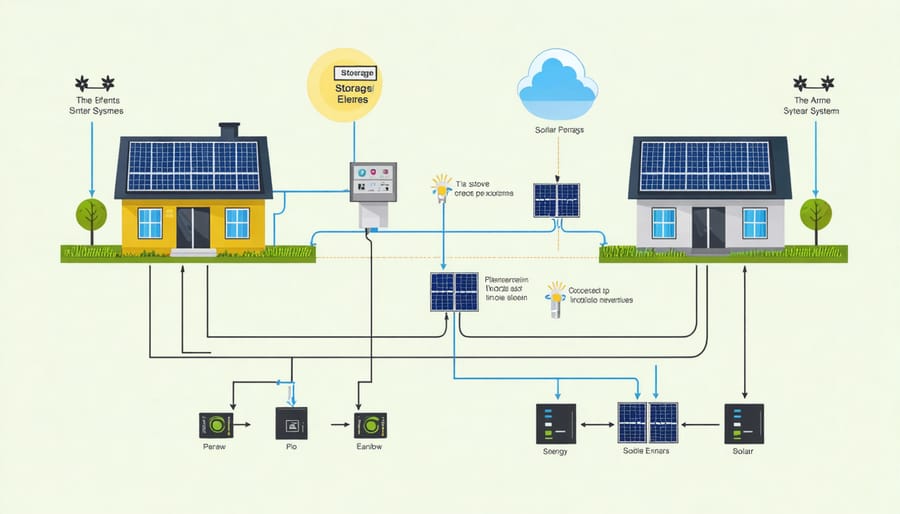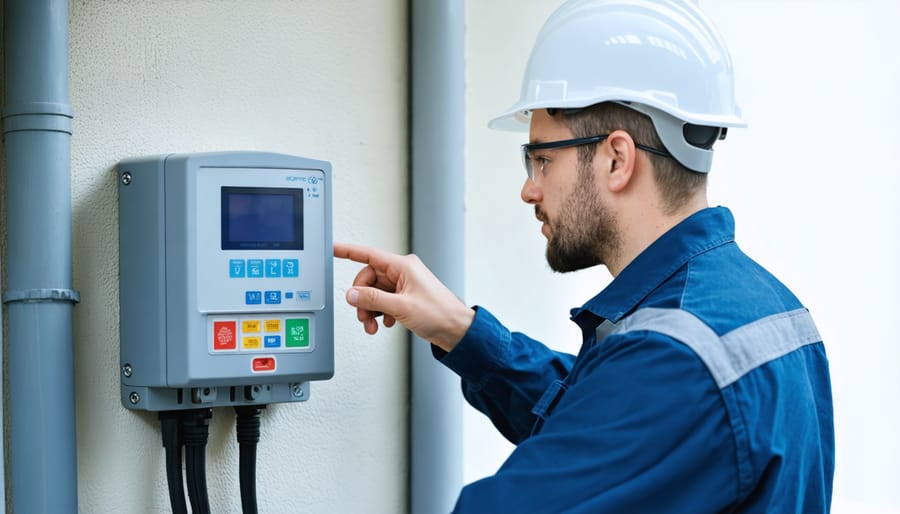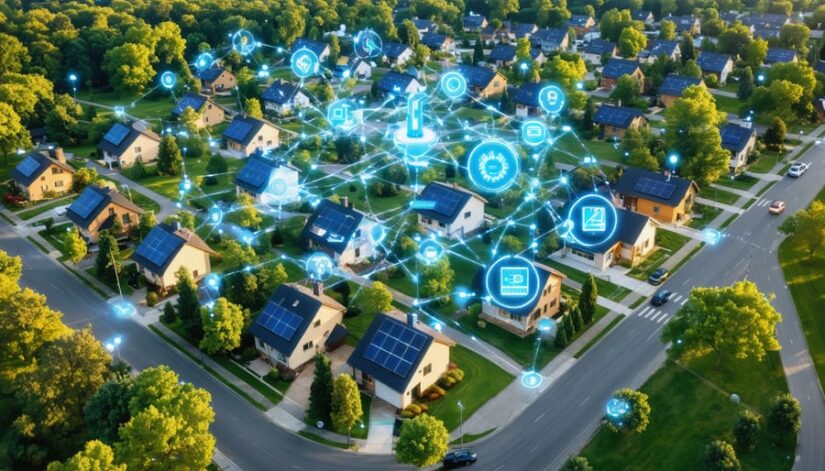How DOE Connected Communities Are Revolutionizing Illinois Energy Sharing
Imagine a neighborhood where homes and businesses don’t just consume energy – they share it, store it, and trade it seamlessly through an intelligent network. That’s the transformative vision behind DOE Connected Communities, a groundbreaking initiative reshaping how Illinois residents interact with energy. These smart energy networks link solar panels, battery storage systems, and advanced meters across multiple properties, creating resilient microgrids that optimize power distribution in real-time.
By connecting homes, businesses, and community resources through sophisticated energy management systems, these networks deliver remarkable benefits: reduced utility costs, enhanced grid reliability, and accelerated clean energy adoption. In Illinois alone, connected communities are demonstrating how shared solar resources and coordinated energy management can help neighborhoods slash peak demand by up to 30% while providing a reliable backup power source during outages.
Think of it as a localized energy ecosystem where every participant – from homeowners to local businesses – becomes both an energy consumer and producer, working together to create a more sustainable and resilient power grid. This innovative approach to energy management represents the future of community-based clean energy solutions, offering Illinois residents a practical path toward energy independence and environmental stewardship.
What Are DOE Connected Communities?
Key Components of Connected Communities
Connected communities rely on several integrated technologies working seamlessly together to create efficient, sustainable energy networks. At the core is smart grid integration, which enables two-way communication between utility providers and consumers through smart home energy systems. These systems monitor and optimize energy usage in real-time, helping residents and businesses reduce costs while maintaining comfort.
Renewable energy systems form another crucial component, with solar panels and wind turbines generating clean power locally. This distributed generation approach reduces reliance on traditional power plants and decreases transmission losses. Energy storage solutions, including advanced battery systems, help balance supply and demand by storing excess renewable energy for use during peak periods or cloudy days.
Advanced metering infrastructure (AMI) provides detailed consumption data, enabling better energy management decisions. Combined with automated control systems, these technologies create a responsive network that can adjust to changing conditions and energy needs. This integration allows communities to share resources effectively, improve grid reliability, and achieve greater energy independence while reducing their environmental impact.

Benefits for Illinois Residents
Illinois residents participating in DOE Connected Communities can enjoy substantial energy cost savings through improved grid efficiency and shared resources. By joining these innovative networks, homeowners and businesses can reduce their monthly utility bills while contributing to a more resilient power infrastructure.
Connected communities enable local energy sharing during peak demand periods, helping stabilize grid performance and prevent outages. This is particularly valuable during extreme weather events, which have become increasingly common in Illinois. Participants can also benefit from group purchasing power for renewable energy equipment and installation services.
The program creates opportunities for Illinois residents to earn credits by sharing excess solar power with neighbors, effectively lowering their energy costs while supporting local sustainability goals. Additionally, these communities help reduce the strain on aging infrastructure, potentially preventing costly utility upgrades that would otherwise be passed on to consumers.
Smart monitoring systems provided through the program allow residents to track their energy usage in real-time, enabling more informed decisions about consumption patterns and further optimizing savings.
Energy Sharing Networks in Action

Solar Energy Integration
Solar energy integration forms the backbone of connected communities, utilizing advanced photovoltaic systems that transform sunlight into usable electricity. These systems work collaboratively across multiple buildings and homes, creating a localized power network that maximizes energy efficiency and reliability. Modern solar installations include smart inverters that convert DC power from solar panels into AC power for household use, while sophisticated monitoring systems track energy production and consumption in real-time.
In Illinois’s connected communities, solar arrays are strategically positioned to capture maximum sunlight throughout the day. The energy generated is either used immediately or stored in community-scale battery systems for later use. This integrated approach allows residents to share excess power with neighbors, reducing strain on the traditional grid during peak demand periods.
Beyond rooftop installations, these communities often incorporate innovative solutions like solar carports, ground-mounted arrays, and even portable solar solutions for flexible power needs. Advanced energy management systems ensure optimal distribution of solar power, automatically directing electricity to where it’s needed most within the community.
The integration also includes smart meters and home energy management systems that allow residents to monitor and control their energy usage, making it easier to participate in demand response programs and maximize the benefits of shared solar resources.
Smart Grid Technologies
Smart grid technologies form the backbone of connected communities, enabling intelligent energy management and distribution. These advanced systems use digital communications and automated controls to create a more responsive and efficient power network. At the heart of these systems are smart meters, which provide real-time energy usage data and enable two-way communication between utilities and consumers.
Advanced monitoring systems track power flow and quality across the network, automatically detecting and responding to changes in demand or potential issues. This helps prevent outages and ensures stable power delivery throughout the community. Distribution automation systems allow for remote control of grid equipment, making it possible to reroute power around problems and balance loads more effectively.
Energy management systems integrate with home automation devices, allowing residents to optimize their energy use based on real-time pricing and availability. Smart inverters work alongside these systems to manage the flow of solar power into the grid, ensuring smooth integration of renewable energy sources.
Data analytics platforms process information from across the network, providing insights that help utilities and community managers make informed decisions about energy distribution and infrastructure improvements. These platforms also enable predictive maintenance, helping to prevent equipment failures before they occur and reducing maintenance costs.
The implementation of these technologies creates a more resilient and efficient power network, benefiting both utilities and consumers through improved reliability and reduced energy costs.
Implementation in Illinois Communities

Technical Requirements
To participate in a connected community project, properties need to meet specific technical requirements that ensure smooth integration with the broader energy network. The foundation starts with smart meters capable of two-way communication, allowing real-time monitoring of energy consumption and production. These meters must comply with Illinois utility standards and support automated data collection.
For solar-equipped properties, modern inverters with grid-interactive capabilities are essential. These devices need to meet IEEE 1547-2018 standards and include features like voltage ride-through and remote control functionality. Properties should also have reliable internet connectivity to enable continuous communication with the network management system.
Energy storage systems, while not always mandatory, significantly enhance participation capabilities. Battery systems should have a minimum capacity of 5kWh and support both AC and DC coupling configurations. Smart thermostats and energy management systems that can respond to grid signals are recommended for optimal participation.
The electrical panel must be updated to accommodate bidirectional power flow and should include necessary safety equipment like automatic transfer switches and surge protection devices. Properties require sufficient space for additional control equipment installation, typically about 4 square feet of wall space near the existing electrical panel.
Network security is crucial, with all connected devices requiring encryption capabilities and compliance with utility cybersecurity protocols. Regular software updates and maintenance ensure continued secure operation within the connected community framework.
Regulatory Framework
Illinois has established a robust regulatory framework to support the development and implementation of connected communities. The Illinois Power Agency Act and the Climate and Equitable Jobs Act (CEJA) of 2021 provide the foundation for these innovative energy sharing networks. These regulations ensure fair participation, establish safety standards, and outline the requirements for utilities and participants.
Under current state guidelines, connected communities must register with the Illinois Commerce Commission and comply with specific interconnection standards. The Illinois Distributed Generation Interconnection Standard provides clear protocols for connecting renewable energy systems to the grid, while the Smart Inverter Rebate Program offers financial incentives for participants.
Property owners interested in joining connected communities benefit from net metering policies that allow them to receive credits for excess energy shared with the grid. The state’s renewable portfolio standard (RPS) further supports these initiatives by requiring utilities to source an increasing percentage of their power from renewable sources.
Recent policy updates have streamlined the approval process for community energy projects and established consumer protection measures. These regulations ensure transparency in billing, fair compensation for energy sharing, and clear dispute resolution procedures. Additionally, special provisions exist for low-income communities and environmental justice areas, making connected communities more accessible to all Illinois residents.
Future of Energy Sharing in Illinois
Illinois stands at the forefront of an energy revolution, with several promising developments on the horizon for community-based energy sharing. The state’s commitment to renewable energy is driving innovations in how neighborhoods and communities can collaborate on power distribution and management.
In the coming years, Illinois residents can expect to see more microgrid projects expanding across communities, allowing for greater energy independence and reliability. These systems will integrate with existing personal energy generation solutions while enabling smoother power sharing between neighbors.
The Illinois Commerce Commission is currently developing new frameworks to facilitate peer-to-peer energy trading, which will allow homeowners and businesses to buy and sell excess solar power directly within their communities. This democratization of energy is expected to reduce costs while increasing grid resilience.
Additionally, several pilot programs are launching across the state to test advanced energy storage solutions and smart grid technologies. These initiatives will help communities better manage peak demand periods and optimize their energy consumption patterns.
Looking ahead, experts predict that connected communities in Illinois will increasingly incorporate artificial intelligence and machine learning to automate energy distribution, making the system more efficient and responsive to community needs. This evolution in energy sharing will create new opportunities for local job creation and economic growth while supporting the state’s clean energy goals.
Connected communities represent a transformative approach to energy management in Illinois, offering unprecedented opportunities for sustainable power sharing and cost reduction. By participating in these DOE-supported initiatives, residents and businesses can play a vital role in creating a more resilient and efficient energy future. Whether you’re a homeowner interested in solar panels or a business looking to optimize energy usage, there’s a place for you in this growing network. Take the first step by contacting local energy providers, attending community meetings, or reaching out to solar energy experts. Together, we can build a more sustainable Illinois through innovative energy solutions and collaborative community engagement. Join us in shaping the future of connected communities today.


